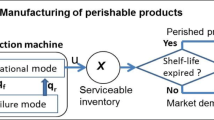Abstract
The paper addresses a problem of product recovery management where a single product is stocked in order to fulfill a stochastic demand of customers who may return products after usage, thus generating also stochastic product returns. The material flow can be controlled by procuring new products on the one hand, and by remanufacturing or disposal of returned items on the other. A situation is considered where all costs are proportional and where remanufacturing as well as procurement needs a fixed deterministic leadtime which can be different for both activities. For periodic review control it is shown how the optimal decision rules for procurement, remanufacturing and disposal can be evaluated by exploiting the functional equations of a dynamic programming formulation. The serious impact of leadtimes on the complexity of the control rule is elaborated, and it is demonstrated for which leadtime situations simple optimal policies can be derived.
Zusammenfassung
Es wird ein Lagerhaltungsproblem mit stochastischer Nachfrage betrachtet, bei dem Produkte nach Gebrauch wieder zurückgegeben werden können. Diese gebrauchten Güter, deren Rückfluß ebenfalls stochastischer Natur ist, können entweder nach entsprechender Aufarbeitung wiederverwendet oder müssen entsorgt werden. Außer durch Wiederaufarbeitung kann die Versorgung mit marktfähigen Produkten durch Neubeschaffung erfolgen. Es wird davon ausgegangen, daß nur proportionale Kosten für die einzelnen Aktivitäten auftreten und daß sowohl Wiederaufarbeitung als auch reguläre Beschaffung mit festen Durchlaufzeiten bzw. Lieferzeiten verbunden sind. Es wird für den Fall periodischer Kontrolle gezeigt, wie die optimale Entscheidungsregel für Beschaffung, Aufarbeitung und Entsorgung mit Hilfe der stochastischen dynamischen Programmierung untersucht werden kann. Dabei wird der entscheidende Einfluß von Durchlauf- und Lieferzeit auf die Komplexität der Entscheidungsregel herausgearbeitet. Schließlich wird gezeigt, für welche Situationen optimale Regeln einfacher Struktur abgeleitet werden können.
Similar content being viewed by others
References
Barad M, Braha D (1996) Control limits for multi-stage manufacturing processes with binomial yield (single and multiple production runs).J. Oper. Res. Soc. 47:98–112
Bulinskaya EV (1964) Some results concerning optimum inventory policies.Theory Probab. Appl. 9:389–403
Eppen GD, Fama EF (1969) Cash balance and simple dynamic portfolio problems with proportional costs.Int. Econ. Rev. 10(2):119–133
Fukuda Y (1961) Optimal disposal policies.Naval Res. Log. Quar. 8:221–227
Fukuda Y (1964) Optimal policies for the inventory problem with negotiable leadtime.Manag. Sci. 10:690–708
Heymann DP (1977) Optimal disposal policies for a single-item inventory system with returns.Naval Res. Log. Quar. 24:385–405
Inderfurth K (1982) Zum Stand der betriebswirtschaftlichen Kassenhaltungstheorie.Z. Betriebswirtschaft 52 (3):295–320 (In German)
Inderfurth K (1996)Modeling periodic review control for a stochastic product recovery problem with remanufacturing and procurement leadtimes. Working paper 2/1996, Faculty of Economics and Management, University of Magdeburg, Germany
Laan EA van der (1993) On inventory control models where items are remanufactured or disposed.Unpublished Master's Thesis. Erasmus University Rotterdam, The Netherlands
Laan EA van der, Salomon M, Dekker R (1995) Production planning and inventory control for remanufacturable durable products.Report 9531/A. Erasmus University Rotterdam, The Netherlands
Lee HL, Nahmias S (1993) Single-product, single-location models. InLogistics of Production and Inventory Graves, Rinnooy Kan, AHG SC, P.H. Zipkin, Eds., North-Holland, Amsterdam, 3–55
Muckstadt JA, Isaac MH (1981) An analysis of single item inventory systems with returns.Naval Res. Log. Quar. 28:237–254
Nahmias S (1981) Managing repairable item inventory systems: a review.TIMS Studies in the Management Sciences 16:253–277, North-Holland Publishing Company, The Netherlands
Salomon M, van der Laan EA, Dekker R, Thierry MC, Ridder A (1994) Product remanufacturing and its effects on production and inventory control.ERASM Management Report Series 172. Erasmus University Rotterdam, The Netherlands
Schneeweiss Ch (1974)Dynamisches Programmieren. Physica-Verlag, Heidelberg
Simpson VP (1978) Optimum solution structure for a repairable inventory problem.Oper. Res. 26:270–281
Thierry MC, Salomon M, van Nunen JAEE, van Wassenhove LN (1995) Strategic production and operations management issues in product recovery management.Calif. Manag. Rev. 37 (2): 114–135
Whisler WD (1967) A stochastic inventory model for rented equipment.Manag. Sci. 13:640–647
Author information
Authors and Affiliations
Rights and permissions
About this article
Cite this article
Inderfurth, K. Simple optimal replenishment and disposal policies for a product recovery system with leadtimes. OR Spektrum 19, 111–122 (1997). https://doi.org/10.1007/BF01545510
Received:
Accepted:
Issue Date:
DOI: https://doi.org/10.1007/BF01545510




